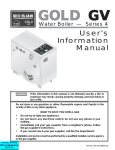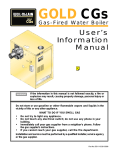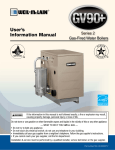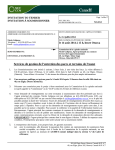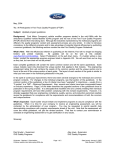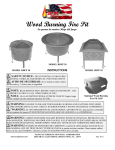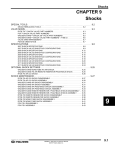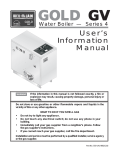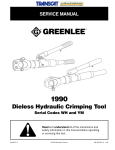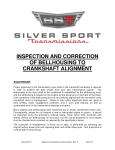Download Air 2.0 Service Manual English
Transcript
Service_Procedures Ride Control, LLC. 950 Maplelawn Troy, MI 48084 USA 800-999-3903 rydefx.com Information contained in this publication was in effect at the time the publication was approved for printing and is subject to change without notice or liability. Ride Control, LLC., reserves the right to revise the information presented or to discontinue the production of parts described at any time. Ride Control, LLC. All Rights Reserved Copyright 2009 Printed in USA MM-0788 December, 2011 Hazard_Alert_Messages_ Read and observe all Warning and Caution hazard alert messages in this publication. They provide information that can help prevent serious personal injury, damage to components, or both. How to Obtain Additional Maintenance and Service Information Call 1-800-999-3903 or email [email protected] How to Obtain Special Tools and Supplies Specified in This Bulletin Call 1-800-999-3903 or email [email protected] Required_Tools_ • • • • • • • • • Interlocking Channel Pliers 5/64” Allen Wrench Slotted Head Screwdriver Torque Wrench 1/2” Wrench Vernier Calliper or Micrometer Pic Tool Nitrogen Regulator Air Compressor with blow gun attachment Specialty_Tools_ • • • RydeFX Gas Charge Tool (Inflation Needle) Ryde Control P/n: 390300 RydeFX I.F.P Extraction / Locator Tool Ryde Control P/n: 390304 RydeFX Air Pump (Included) NOTE: The 40mm Chrome Rod (O.D.) has a 36mm (I.D.) pressure chamber that uses a 36mm Internal Floating Piston. RydeFX Air_2.0 1 Service Procedures Disassembly_ n Warning_ To prevent serious eye injury, always wear safe eye protection when you perform maintenance or service procedures. 1. Wear safe eye protection. 2. Remove the shock from the vehicle. Refer to your snowmobile owners manual for instructions on proper removal procedures. n Warning_ Before using a solvent cleaner, you should be aware that it can be flammable, poisonous and cause burns. Some examples of solvent cleaners are carbon tetrachloride, and emulsion-type and petroleumbase cleaners. Carefully read and follow the manufacturer's instructions. Wear safe eye protection and clothing that protects your skin. Do not use gasoline, or solvents that contain gasoline. Gasoline can explode. Also take care that you correctly use hot solution tanks or alkaline solutions. Carefully read and follow the manufacturer's instructions. 3. Wash the shock body parts in a solvent cleaner. Use compressed air to remove sand and dirt, and dry components. Figure 2.0 4. Remove bearing, sleeve and/or bushings from lower shock mount eyelet. Use a vise with soft-jaws to secure the lower mount of the shock absorber. If you secure the shock absorber using any other method, you can damage or mark the shock absorber body cylinder. Figure 2.0 RydeFX Air_2.0 2 Service Procedures Figure 3.0 5. Use Allen wrench to remove the small button head screws from the pressure valve assemblies at both ends of the shock absorber. Figure 3.0 n Warning_ The shock absorber contains nitrogen gas that is under extreme pressure. You must release all of the pressurized gas from the shock absorber before removing the pressure valve assembly. Use caution when releasing the gas and allow the pressure to discharge completely. Servicing a shock absorber that contains pressurized gas can cause the gas and shock absorber oil to eject the pressure valve assembly from the shock absorber body cylinder. Serious personal injury and damage to components can occur. Figure 4.0 6. Loosen the pressure valve assemblies on both ends of the shock absorber by using a slotted screwdriver to turn the pressure valve assembly screw counterclockwise two full rotations. Allow gas pressure to fully escape past each valve assembly O-ring. Gas chambers are depressurized when there is no audible sound of escaping gas Figure 4.0 n Warning_ Nitrogen gas is under extreme pressure. Use caution when releasing nitrogen gas from shock. Protective eyewear should be worn to avoid risk of injury. RydeFX Air_2.0 3 Service Procedures 7. Using a slotted screwdriver, remove the pressure valve assemblies from both ends of the shock absorber. Figure 5.0_5.1 Figure 5.1 Figure 5.0 8. Use interlocking channel pliers to grip cylinder head and turn counter clockwise to loosen and remove cylinder head assembly. Figure 6.0_6.1 Figure 6.1 Figure 6.0 9. Pour the shock oil out of the large diameter shock absorber cylinder. Discard the used oil into an approved storage container and dispose of it appropriately. Do not reuse the damper oil. Always use new oil for assembly procedures. RydeFX Air_2.0 4 Service Procedures Figure 7.0 10. Using the compressed air blow gun, invert large diameter shock absorber cylinder on top of a folded shop rag. Hold the shock absorber firmly in place. Position the blow gun nipple into the cylinder pressure valve port. Charge the cylinder with 90 psi to remove the internal floating piston (I.F.P) from main working cylinder. Verify that the wear band and O-ring are removed along with the internal floating piston (I.F.P). Figure 7.0 11. Clean the inside of the shock absorber body with a solvent cleaner. Use compressed air to dry the shock absorber. Figure 8.0 12. Place the 40mm piston rod upper mount into a bench vise. Remove the piston and valve. Arrange the parts in the order you disassembled them. Figure 8.0 13. Inspect the following parts for wear and damage. Replace worn or damaged parts. a. 40mm Piston rod for straightness, nicks or burrs. b. Cylinder Head Assembly / DU Bearing – clean, inspect, or replace. c. Inside of shock body for scratches, burrs or excessive wear. d. Teflon piston and I.F.P wear band for cuts, chipped or nicked edges, or excessive wear. e. O-rings for nicks, cuts, or cracks. f. Valve discs for kinks or waves. g. Compression bumpers (ski shocks only) for chipping, cracking or being missing. RydeFX Air_2.0 5 Service Procedures Assembly_ 1. Place the 40mm piston rod upper mount into the soft-jaw vise. Reassemble piston rod assembly in the order you disassembled it. Verify that the rebound and compression disc (shim) stacks are in the same order that they were before disassembly. n Caution_ Tighten the locking bolt to 28-32 ft-lb (39-44 Nm.). Do not overtighten the bolt. Damage to the piston and valves will occur. n Warning_ Take care when you use LOCTITE® adhesive to avoid serious personal injury. Read the manufacturer's instructions before using this product. Follow the instructions carefully to prevent irritation to the eyes and skin. If LOCTITE® adhesive material gets into your eyes, follow the manufacturer's emergency procedures. Have your eyes checked by a physician as soon as possible. Figure 10.0 2. Apply LOCTITE® 290 threadlocking compound to the inside thread of the 40mm rod. Thread the piston assembly by hand. Use a torque wrench to tighten the locking bolt to 28-32 ft-lb (39-44 Nm.). Do not overtighten the locking bolt. Figure 10.0_10.1_10.2 Figure 10.2 Figure 10.1 RydeFX Air_2.0 6 Service Procedures 3. Apply of light film of white lithium grease to the counter bore of the 40mm piston rod pressure valve port. Figure 11.0 4. Use torque wrench to install the pressure assembly into the 40mm piston rod valve port and tighten to 100-110 in-lb (12-13 Nm.). Figure 11.0 NOTE: If you are using the RydeFX inflation tool to pressurize the piston rod assembly, refer to Procedures for Use of Replaceable Inflation Needle in the instruction manual included with the RydeFX tool case. 5. Pressurize the 40mm piston rod assembly by adding nitrogen gas or compressed air through the pressure valve to the specified pressure (reference specification chart for correct gas pressure) The internal floating piston will be forced to the top of the cylinder beneath the piston rod assembly. The 40mm piston rod assembly is now fully pressurized.Figure 12.0_12.1 Figure 12.1 Figure 12.0 Schrader valve adaptor may not be exactly as illustrated RydeFX Air_2.0 7 Service Procedures Figure 13.0 6. Use a vise with soft-jaws to secure the lower mount of the shock absorber. If you secure the shock absorber using any other method, you can damage or mark the shock absorber body cylinder. Figure 13.0 NOTE: Depending on which shock absorber you are servicing, adjust the I.F.P location tool to the specified depth. Figure 14.0 7. Thread the positioning head onto the I.F.P locator tool and adjust the top of the value indicator to the specified depth from the top of the 47mm cylinder (reference specification chart for correct depth measurement). Figure 14.0 Figure 15.0 8. Apply a thin film of shock oil onto the floating wear band and O-ring. Install the floating piston into the top of the shock absorber body. Position the piston approximately 1.0” (25mm) in depth. Figure 15.0 RydeFX Air_2.0 8 Service Procedures Figure 16.0 9. Using the I.F.P Locator tool as a handle, push the floating piston down into the shock absorber, until the value indicator knob contacts the shock absorber body. Take care not to damage the I.F.P wear band and O-ring. The piston should now be positioned correctly. Figure 16.0 10. Apply of light film of white lithium grease to the counter bore of the 40mm piston rod pressure valve port. Figure 17.0 11. Use torque wrench to install the pressure assembly into the 47 cylinder valve port and tighten to 100-110 in-lb (12-13 Nm.). Figure 17.0 NOTE: During installation some shock absorber oil will overflow. Wrap a shop cloth around the shock absorber body to absorb any overflow. Figure 18.0 12. Fill the shock absorber body with new shock oil, preferably RydeFX SLIDE oil (reference specification chart for correct oil volume). Allow a couple of minutes for all the air bubbles to rise to the top to ensure no air is trapped. Trapped air can affect damper performance. Figure 18.0 RydeFX Air_2.0 9 Service Procedures Figure 19.0 13. Inverted 40mm piston rod assembly. Pour a small amount of shock oil into the center of the locking piston bolt, until oil purges from the bolt. Figure 19.0 Figure 20.0 14. With the cylinder head assembly pushed down against the piston, carefully insert the piston rod assembly into the cylinder. Slightly rotate the piston rod to allow piston to enter shock body bore. Figure 20.0 NOTE: Slowly push the piston rod and assembly into shock body. If you push it too quickly, you will displace the internal floating piston (I.F.P) from its original position, which can affect damper performance. 15. Slowly push the piston rod and assembly into the shock absorber body, until the cylinder head assembly bottoms on the cylinder counter bore. Use a slight up-and-down movement, if necessary, to allow all air to pass through the piston assembly. Figure 21.0 16. Use interlocking channel pliers to grip the cylinder head. Turn the head clockwise to tighten it securely onto the shock absorber cylinder. Figure 21.0 RydeFX Air_2.0 10 Service Procedures NOTE: If you are using the RydeFX inflation tool to pressurize the 47mm shock absorber cylinder, refer to Procedures for Use of Replaceable Inflation Needle in the instruction manual included in the RydeFX tool case. 17. Pressurize the shock absorber 47mm main working cylinder by adding nitrogen gas or compressed air through the pressure valve to the specified pressure (reference specification chart for correct gas pressure). Once the shock absorber is pressurized, the piston rod should fully extend from the shock absorber body. Figure 22.0_22.1 Figure 22.1 Figure 22.0 Schrader valve adaptor may not be exactly as illustrated 18. Install the small button head screw into the pressure valve assembly and tighten securely. 19. Reinstall sleeve and bushings in lower shock absorber mount. RydeFX Air_2.0 11 Service Procedures 1 3 4 2 5 6 7 8 9 10 11 12 14 13 ITEM 1 2 3 4 5 6 7 COMPONENT END CAP COMPRESSION BUMPER BUSHING SLEEVE CYLINDER HEAD ASSEMBLY INTERNAL FLOATING PISTON (IFP) IFP O-RING RydeFX Air_2.0 ITEM 8 9 10 11 12 13 14 12 Service COMPONENT ROD HEAD ASSEMBLY + SPRING PISTON TOP OUT WASHER PISTON BUSHING IFP O-RING WEAR BAND VALVE SCREW PRESSURE VALUE Procedures Air_Pump_and Schrader_Valve_Kit_ All aftermarket RydeFX AIR 2.0 shock absorbers come with an optional air pump and Schrader valve kit which can be used as an alternative method to adjusting the pressure of the shock absorber air spring. Installing the Schrader valve kit, along with use of the air pump, accommodates the ease of adjustment to the 47mm cylinder spring pressure while on the trail or as a substitute to using nitrogen gas with the RydeFX Gas Fill Tool (P/n: 390300). n Warning_ To prevent undesirable changes in dampening performance, it is recommended that you follow the manufacturer guidelines when making air pressure and IFP (Internal Floating Piston) adjustments to your AIR 2.0 shock absorbers with the Schrader valve kit. GAS PRESSURE ADJUSTMENTS TO SPRING PRE-LOAD 47mm Aluminum Cylinder Gas Chamber Adjustments It is recommended that adjustments are only made to the gas chamber in the 47mm aluminum cylinder as this modifies the initial air spring pressure (preload) of the shock stroke and should be a sufficient adjustment for the majority of riders. Use only Air or Nitrogen gas when making adjustments to air spring pressure. It is recommended that you do not increase the pressure in the 47mm aluminum cylinder gas chamber by more than 20-40 PSI at a time or beyond a maximum pressure of 100 PSI. n Caution_ A change of 5 PSI in either direction can have a significant impact on ride quality. Adjustments to air pressure should be made in small increments to avoid harsh handling. RydeFX Air_2.0 13 Service Procedures 40mm Piston Rod Gas Chamber Adjustments It is recommended that you do not adjust the pressure in the 40mm chrome cylinder. It has been set-up from the factory to ensure there is sufficient stroke while preventing the shock from bottoming out. The gas chamber in the 40mm chrome cylinder is charged to 160 PSI from the factory and adjusts the final portion of the shock stroke. PROCEDURES FOR INSTALLING SCHRADER VALVE KIT n Warning_ To prevent serious eye injury, always wear safe eye protection when you perform maintenance or service procedures. 1. Wear safe eye protection 2. Use Allen wrench to remove the small button head screw from pressure valve assembly from the 47mm cylinder end. n Warning_ The shock absorber contains nitrogen gas that is under extreme pressure. You must release all of the pressurized gas from the shock absorber before removing the pressure valve assembly. Use caution when releasing the gas and allow the pressure to discharge completely. Servicing a shock absorber that contains pressurized gas can cause the gas and shock absorber oil to eject the pressure valve assembly from the shock absorber body cylinder. Serious personal injury and damage to components can occur. 3. Loosen pressure value assembly by using a slotted screwdriver to turn the pressure valve assembly screw counter clockwise two full rotations. Allow gas pressure to fully escape past the valve assembly O-ring. The gas chamber is depressurized when there is no audible sound of escaping gas. 4. Remove the pressure valve assembly from the 47mm cylinder end. 5. Thread the Schrader valve assembly in clockwise and hand tighten using a 1/2” wrench. RydeFX Air_2.0 14 Service Procedures Pump_Instructions_ To Use: 1. Thread silver pump head onto shock absorber valve 2. Inflate shock absorber to desired pressure 3. Adjust pressure by pressing bleed valve to release 2.0-3.0 psi at a time 4. Unthread pump head from the shock absorber valve NOTE: You may hear a release of air when you detach the pump from the shock absorber valve. This air is being released from the pump hose, not from the shock absorber. MM-0788 Issued April 15, 2007 Page 7 Copyright Ride Control LLC. 2009 RydeFX Air_2.0 15 Service Procedures

















